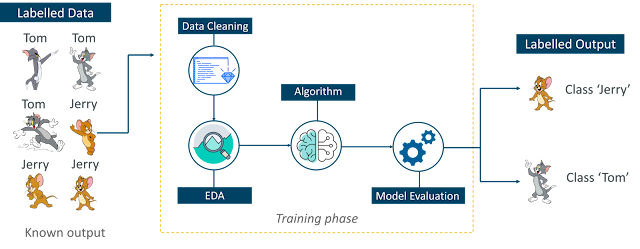Definition: the use and development of computer systems that are able to learn and adapt without following explicit instructions, by using algorithms and statistical models to analyse and draw inferences from patterns in data.
Why Machine Learning?
The world today is evolving and so are the needs and requirements of people. Furthermore, we are witnessing a fourth industrial revolution of data.
In order to derive meaningful insights from this data and learn from the way in which people and the system interface with the data, we need computational algorithms that can churn the data and provide us with results that would benefit us in various ways.
Machine Learning has revolutionized industries like medicine, healthcare, manufacturing, banking, and several other industries. Therefore, Machine Learning has become an essential part of modern industry.
How does Machine Learning Work?
Types of Machine Learning
Machine Learning Algorithms can be classified into 3 types as follows –
- Supervised Learning
- Unsupervised Learning
- Reinforcement Learning
Supervised learning
Supervised learning is that the machine learning task of learning a function that maps an input to an output supported example input-output pairs.
In Supervised Learning, the dataset on which we train our model is labeled. There is a clear and distinct mapping of input and output. Based on the example inputs, the model is able to get trained in the instances.
An example of supervised learning is spam filtering.
Based on the labeled data, the model is able to determine if the data is spam or ham. This is an easier form of training.
Unsupervised Learning
Unsupervised Learning may be a machine learning technique during which the users don’t got to supervise the model. Instead, it allows the model to figure on its own to get patterns and knowledge that was previously undetected. It mainly deals with the unlabeled data.In Unsupervised Learning, there is no labeled data. The algorithm identifies the patterns within the dataset and learns them. The algorithm groups the data into various clusters based on their density. Using it, one can perform visualization on high dimensional data.
One example of this type of Machine learning algorithm is the Principle Component Analysis.
Reinforcement Learning
Reinforcement learning is one among three basic machine learning paradigms, alongside supervised learning and unsupervised learning.
Reinforcement Learning is an emerging and most popular type of Machine Learning Algorithm. It is used in various autonomous systems like cars and industrial robotics. The aim of this algorithm is to reach a goal in a dynamic environment. It can reach this goal based on several rewards that are provided to it by the system.
It is most heavily used in programming robots to perform autonomous actions. It is also used in making intelligent self-driving cars




0 comments :
Post a Comment
Note: only a member of this blog may post a comment.